○ A soccer team from Southwest China's Tibet Autonomous Region made history with its first win in China's professional league.
○ Chengtou football club now has four youth training teams and 50 Tibetan players.
○ Veteran Tibetan footballers are hopeful of reviving soccer in the region, but high altitude and other challenges present barriers to the plan
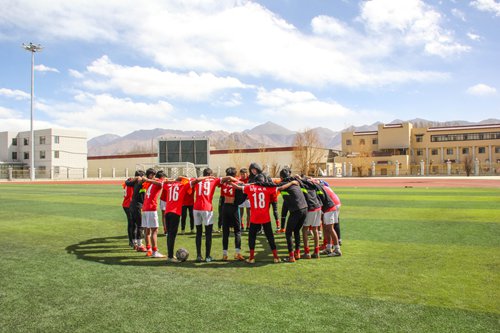
Players and staff from the Lhasa Urban Construction Investment Football Club (Chengtou) had left them at the Qujing Culture and Sports Center in Southwest China's Yunnan Province.
They had just beaten Yunnan Kunlu Football Club 5:2 in the second round of the Chinese Football Association Division Two League (C2L).
It was the first win in C2L for Chengtou, a newbie to the league. It was also the first time in history a team from Southwest China's Tibet Autonomous Region had won a game in a professional Chinese soccer league.
Their league opener on March 16 saw them lose to Suzhou Dongwu.
Chengtou, founded on March 29, 2017, started in the amateur league and went professional after one year.
For decades, soccer had been the most popular sport in Tibet. But in the 1990s, when Chinese soccer went professional, Tibet did not follow the trend.
"Tibetan soccer was a vacuum for almost two decades," Tang Zesheng, head of youth training at Chengtou, as well as a retired Tibetan soccer player, told the Global Times.
Now, Chengtou is bringing new hope for soccer to the high plateaus, and rekindling the region's old passion for the sport.
Veteran footballers like Tang have come to Chengtou to serve as coaches in the hope of helping the team grow.
The club currently has four youth training teams, with 50 young Tibetan players aged from 13 to 17, and eight Tibetan coaches.
However, the development of Tibetan soccer still faces many challenges. Due to its high altitude and lack of oxygen, finding a proper home ground has proven a major headache for the club.
Sky-high field
"Come here, kid. You go and play on the right," ordered Tsewang Namgyal, youth training coach of the players aged 13 to 15 at Chengtou as he ushered one boy onto the field.
After all the players were told their positions, they got into a circle and shouted "Jiayou!" in mutual encouragement.
That day, the players were split into two sides, one group wearing fluorescent yellow vests.
The arena has a new artificial turf encircled by a red plastic track. On one side is a stand for spectators.
The training field is set against the backdrop of Tibet's unique brown, cutting mountains and clear blue sky, reminding you that you are 3,650 meters above sea level.
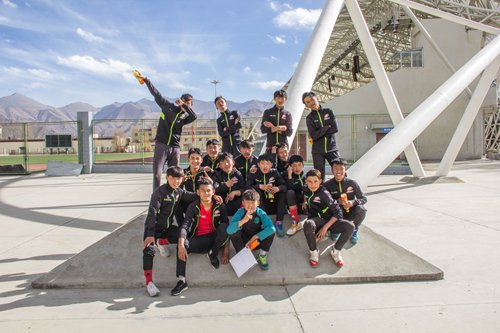
While generous in his praise, when he saw a problem, he would call a halt to the game and give the kids guidance.
It was almost 4 pm, and the harsh sunlight of the high plateau shone directly from the south. It kept everyone warm for a while, but then gusting winds came and blew sand in their faces, bringing the bitter cold of late winter.
The boys have become deeply tanned after training in these conditions for such a long time.
On the other side of the field, the older players aged between 16 and 18 were practicing their shooting, which culminated in an exciting penalty training session.
Great endurance
Jampa Ramgye from Qamdo was sitting outside the ground. He told the Global Times that his feet hurt that day, so he had taken a day off from training.
The 15-year-old defender has been playing soccer for two years. He is skinny and small for his age, and looks more like a 12-year-old.
He said his favorite team was Germany. But when his teammates reminded him that the Germans were knocked out in the group stages of the 2018 World Cup in Russia, he changed his favorite team to Italy, which did not even make it to last year's tournament.
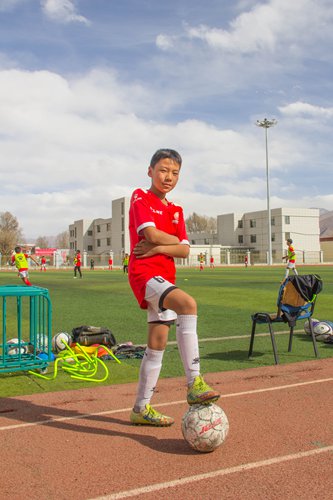
His home is just on the next street, but he could only go back on weekends.
The Chengtou youth training program uses the grounds of the regional sports school of Tibet. The kids who train also live in the dormitories here.
Wangdrak explained that they go running after they get up. In the morning, they take classes, including Chinese language, Tibetan language, maths, politics and English. In the afternoon, they train for two and a half hours.
"Our Tibetan children in general are smaller than their peers, because they grow slower due to the high altitude and the cold," Tang, the head coach, told the Global Times.
"But if you put them in other parts of China and let them stay there for two years, they would become very strong," Tang said. Even in his 50s, the former first-choice goalkeeper of the Tibet regional soccer team still looked physically strong and fit.
"Also, they have great endurance," he said.
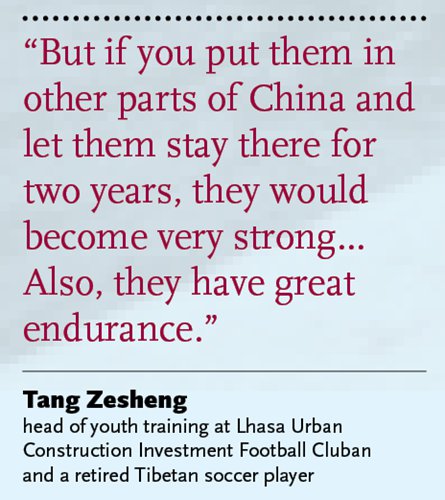
According to the Chinese Football Association's licensing regulations, C2L clubs must have at least four youth training teams, U17, U15, U14 and U13.
Over the last two years, Tang has been recruiting young players from around Tibet. In addition to those selected from regional sports schools, he has also driven thousands of kilometers in search of young talents.
Some of the players are from Gyirong town,
a port bordering China and Nepal that is more than 800 kilometers from Lhasa.
Dorje, a young player from Gyirong, is from the Daman people. The Damans had been without a nationality until 2003, when the State Council of China approved giving them Chinese citizenship.
New ambition
Soccer was introduced to Tibet by the British in the early 20th century. From the 1920s to 1950s, it became popular among Tibetan nobles, and teams such as Lhasa United and Potala Palace were established, the China News Service reported.
After the democratic reform in 1959, soccer became popular among ordinary people. People playing soccer in streets or in monasteries became a common sight. In the 1980s, watching Tibet's local soccer leagues was a popular form of weekend entertainment for people.
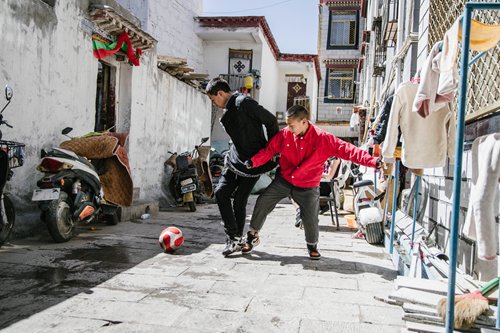
"The national department at that time valued Tibetan soccer a lot and dispatched national-level coaches to Tibet every year," China News Service quoted a player of "the old Tibetan team" as saying.
However, in 1994, when professional soccer leagues were being established in China, Tibet lacked young players and funds. The Tibetan team found itself marginalized from the marketization process.
"After that, we worked in local sports departments, but had nothing to do with soccer. We felt lost," Tang said.
When Chengtou was founded, Tang and his former teammates, many of whom had already retired, joined the club, hoping to make a contribution.
"We have ambition. We want to make Tibetan soccer prosper again," he said.
Calling card
However, bringing Tibetan soccer back to its former glory won't happen overnight.
There are even concerns about where they can hold their home games.
At an altitude of 3,650 meters, Lhasa is not a viable option.
When Chengtou played a match in November 2017 at the Lhasa Recreational and Sports Centre, players had to take oxygen breaks every 15 minutes during the game, Reuters reported.
In 2007, "FIFA banned matches being played at more than 2,500m above sea level," but later suspended the ban due to protests, BBC reported.
Last year, Chengtou played in Nyingchi, a city 400 kilometers from Lhasa at an altitude of 2,900 meters. "Games in Nyingchi had a great atmosphere. We even won 'best home' last year," Tang said.
However, this year, the club was not allowed to set up their home ground in Nyingchi. The team decided to head to Deyang of Southwest China's Sichuan Province, 2,160 kilometers from Lhasa.
On April 7, the team will play its first home game in the fourth round of C2L.
"We hope the CFA will give Tibetan soccer more support," Tang said.
Yan Peilong, manager of the Chengtou club, told the Global Times that since the club started from nothing, they have to learn the ways and rules of operating a club step by step. To further compound their problems, the youth training program lacks professional coaches.
However, everyone in the club is hopeful for Tibetan soccer. "We want soccer to become a window to show Tibet to the world. We hope soccer will become a name card for Tibet."

○ Chengtou football club now has four youth training teams and 50 Tibetan players.
○ Veteran Tibetan footballers are hopeful of reviving soccer in the region, but high altitude and other challenges present barriers to the plan

Youth players from the Lhasa Urban Construction Investment Football Club train on March 13. Photo: Shan Jie/GT
A white hada, a traditional ceremonial silk scarf, was spread on the dressing room table, with a piece of paper saying "Thank you" in Chinese and Tibetan.Players and staff from the Lhasa Urban Construction Investment Football Club (Chengtou) had left them at the Qujing Culture and Sports Center in Southwest China's Yunnan Province.
They had just beaten Yunnan Kunlu Football Club 5:2 in the second round of the Chinese Football Association Division Two League (C2L).
It was the first win in C2L for Chengtou, a newbie to the league. It was also the first time in history a team from Southwest China's Tibet Autonomous Region had won a game in a professional Chinese soccer league.
Their league opener on March 16 saw them lose to Suzhou Dongwu.
Chengtou, founded on March 29, 2017, started in the amateur league and went professional after one year.
For decades, soccer had been the most popular sport in Tibet. But in the 1990s, when Chinese soccer went professional, Tibet did not follow the trend.
"Tibetan soccer was a vacuum for almost two decades," Tang Zesheng, head of youth training at Chengtou, as well as a retired Tibetan soccer player, told the Global Times.
Now, Chengtou is bringing new hope for soccer to the high plateaus, and rekindling the region's old passion for the sport.
Veteran footballers like Tang have come to Chengtou to serve as coaches in the hope of helping the team grow.
The club currently has four youth training teams, with 50 young Tibetan players aged from 13 to 17, and eight Tibetan coaches.
However, the development of Tibetan soccer still faces many challenges. Due to its high altitude and lack of oxygen, finding a proper home ground has proven a major headache for the club.
Sky-high field
"Come here, kid. You go and play on the right," ordered Tsewang Namgyal, youth training coach of the players aged 13 to 15 at Chengtou as he ushered one boy onto the field.
After all the players were told their positions, they got into a circle and shouted "Jiayou!" in mutual encouragement.
That day, the players were split into two sides, one group wearing fluorescent yellow vests.
The arena has a new artificial turf encircled by a red plastic track. On one side is a stand for spectators.
The training field is set against the backdrop of Tibet's unique brown, cutting mountains and clear blue sky, reminding you that you are 3,650 meters above sea level.

Youth players from the Lhasa Urban Construction Investment Football Club train on March 13. Photo: Shan Jie/GT
"Pass! Give him the ball!" Coach Tsewang kept shouting in Tibetan and Putonghua, demanding the boys pass as soon as they got the ball.While generous in his praise, when he saw a problem, he would call a halt to the game and give the kids guidance.
It was almost 4 pm, and the harsh sunlight of the high plateau shone directly from the south. It kept everyone warm for a while, but then gusting winds came and blew sand in their faces, bringing the bitter cold of late winter.
The boys have become deeply tanned after training in these conditions for such a long time.
On the other side of the field, the older players aged between 16 and 18 were practicing their shooting, which culminated in an exciting penalty training session.
Great endurance
Jampa Ramgye from Qamdo was sitting outside the ground. He told the Global Times that his feet hurt that day, so he had taken a day off from training.
The 15-year-old defender has been playing soccer for two years. He is skinny and small for his age, and looks more like a 12-year-old.
He said his favorite team was Germany. But when his teammates reminded him that the Germans were knocked out in the group stages of the 2018 World Cup in Russia, he changed his favorite team to Italy, which did not even make it to last year's tournament.

Wangdrak Photo: Shan Jie/GT
Wangdrak, 13, idolizes Paul Pogba. He is a local of Chengguan district of Lhasa city, and a Manchester United supporter.His home is just on the next street, but he could only go back on weekends.
The Chengtou youth training program uses the grounds of the regional sports school of Tibet. The kids who train also live in the dormitories here.
Wangdrak explained that they go running after they get up. In the morning, they take classes, including Chinese language, Tibetan language, maths, politics and English. In the afternoon, they train for two and a half hours.
"Our Tibetan children in general are smaller than their peers, because they grow slower due to the high altitude and the cold," Tang, the head coach, told the Global Times.
"But if you put them in other parts of China and let them stay there for two years, they would become very strong," Tang said. Even in his 50s, the former first-choice goalkeeper of the Tibet regional soccer team still looked physically strong and fit.
"Also, they have great endurance," he said.

Last winter, the Chengtou youth training team went to Kunming, Yunnan Province for three months. The trip gave them a chance to both improve physically and broaden their horizons. This year, they will take part in the league for youth players and showcase their skills.
According to the Chinese Football Association's licensing regulations, C2L clubs must have at least four youth training teams, U17, U15, U14 and U13.
Over the last two years, Tang has been recruiting young players from around Tibet. In addition to those selected from regional sports schools, he has also driven thousands of kilometers in search of young talents.
Some of the players are from Gyirong town,
a port bordering China and Nepal that is more than 800 kilometers from Lhasa.
Dorje, a young player from Gyirong, is from the Daman people. The Damans had been without a nationality until 2003, when the State Council of China approved giving them Chinese citizenship.
New ambition
Soccer was introduced to Tibet by the British in the early 20th century. From the 1920s to 1950s, it became popular among Tibetan nobles, and teams such as Lhasa United and Potala Palace were established, the China News Service reported.
After the democratic reform in 1959, soccer became popular among ordinary people. People playing soccer in streets or in monasteries became a common sight. In the 1980s, watching Tibet's local soccer leagues was a popular form of weekend entertainment for people.

Children play soccer in an alley in Lhasa, Southwest China's Tibet Autonomous Region. Photo: Li Hao/GT
Moreover, its regional team, which Tang belonged to, not only won national soccer tournaments twice in the 1980s, but also represented China in international games."The national department at that time valued Tibetan soccer a lot and dispatched national-level coaches to Tibet every year," China News Service quoted a player of "the old Tibetan team" as saying.
However, in 1994, when professional soccer leagues were being established in China, Tibet lacked young players and funds. The Tibetan team found itself marginalized from the marketization process.
"After that, we worked in local sports departments, but had nothing to do with soccer. We felt lost," Tang said.
When Chengtou was founded, Tang and his former teammates, many of whom had already retired, joined the club, hoping to make a contribution.
"We have ambition. We want to make Tibetan soccer prosper again," he said.
Calling card
However, bringing Tibetan soccer back to its former glory won't happen overnight.
There are even concerns about where they can hold their home games.
At an altitude of 3,650 meters, Lhasa is not a viable option.
When Chengtou played a match in November 2017 at the Lhasa Recreational and Sports Centre, players had to take oxygen breaks every 15 minutes during the game, Reuters reported.
In 2007, "FIFA banned matches being played at more than 2,500m above sea level," but later suspended the ban due to protests, BBC reported.
Last year, Chengtou played in Nyingchi, a city 400 kilometers from Lhasa at an altitude of 2,900 meters. "Games in Nyingchi had a great atmosphere. We even won 'best home' last year," Tang said.
However, this year, the club was not allowed to set up their home ground in Nyingchi. The team decided to head to Deyang of Southwest China's Sichuan Province, 2,160 kilometers from Lhasa.
On April 7, the team will play its first home game in the fourth round of C2L.
"We hope the CFA will give Tibetan soccer more support," Tang said.
Yan Peilong, manager of the Chengtou club, told the Global Times that since the club started from nothing, they have to learn the ways and rules of operating a club step by step. To further compound their problems, the youth training program lacks professional coaches.
However, everyone in the club is hopeful for Tibetan soccer. "We want soccer to become a window to show Tibet to the world. We hope soccer will become a name card for Tibet."


